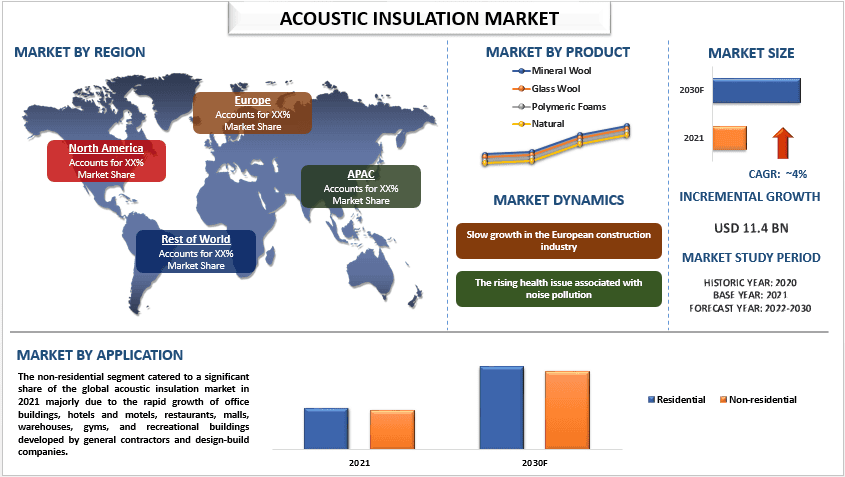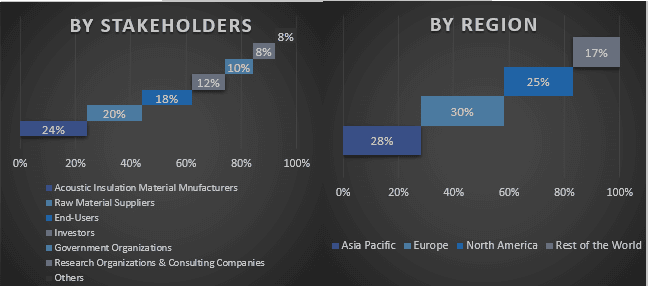
소음 공해와 관련된 건강 문제 증가로 인해 2021년 114억 달러 규모였던 음향 단열재 시장은 약 4%의 꾸준한 성장률을 보일 것으로 예상됩니다. 방음 또는 차음이라고도 하는 음향 단열은 한 영역에서 다른 영역으로의 소리 전달을 줄이거나 제어하는 데 사용되는 기술 및 재료를 의미합니다. 그 목적은 외부 소스에서든 다른 공간 사이에서든 원치 않는 소음의 영향을 최소화하는 것입니다. 음향 단열의 주요 목표는 음파가 통과하는 것을 방지하거나 강도를 크게 줄이는 장벽을 만드는 것입니다. 음파는 압력파의 형태로 공기 또는 기타 물질을 통해 이동하는 진동입니다. 이러한 파동이 장벽을 만나면 반사, 흡수 또는 전달될 수 있습니다. 또한 엄격한 소음 공해 규제와 인프라에서 음향 단열재의 확장은 시장 성장에 도움이 되는 또 다른 요인입니다. 또한 소음 공해 관련 규칙과 특히 아시아 태평양 지역에서 빠르게 성장하는 건설 산업은 시장 성장에 기여하는 가장 두드러진 요인 중 일부입니다. 예를 들어 인도 정부에 따르면 인도 건설 산업은 2025년까지 1조 4천억 달러에 이를 것으로 예상됩니다.
시장에서 활동하는 주요 업체로는 Saint-Gobain Group, ROCKWOOL A/S, Owens Corning, Kingspan Group, Armacell, BASF SE, Knauf Insulation, Fletcher Insulation, Cellecta, Inc. 및 Johns Manville이 있습니다. 고객에게 첨단 혁신적인 제품/기술을 제공하기 위해 이러한 업체들은 파트너십과 함께 여러 M&A를 수행했습니다.
보고서에 제시된 인사이트
"제품 중 폴리머 폼 부문은 예측 기간 동안 두드러진 CAGR로 성장할 것으로 예상됩니다."
제품을 기준으로 시장은 광물솜, 유리솜, 폴리머 폼 및 천연 제품으로 분류됩니다. 폴리머 폼 부문은 건설 산업에 대한 높은 투자로 인해 예측 기간 동안 두드러진 CAGR로 성장할 것으로 예상됩니다. 또한 폴리머 폼이 제공하는 비용 효율성, 먼지 저항, 습기 축적에 대한 저항성과 같은 이점이 부문의 성장에 영향을 미치고 있습니다. 또한 이러한 플라스틱의 견고하고 탄력적인 표면은 높은 수준의 관통 저항을 제공하여 폴리머 폼에 대한 수요를 증가시킵니다.
"응용 분야 중 비주거 부문은 2021년 시장의 상당 부분을 차지했습니다."
응용 분야별로 시장은 주거용과 비주거용으로 나뉩니다. 비주거 부문은 일반 계약자 및 설계-시공 회사가 개발한 사무실 건물, 호텔 및 모텔, 레스토랑, 쇼핑몰, 창고, 체육관 및 레크리에이션 건물의 급속한 성장으로 인해 2021년에 글로벌 음향 단열 시장의 상당 부분을 차지했습니다. 또한 건축 음향 단열재의 비주거 응용 분야는 음향 단열재가 직원 성과 및 생산성을 향상시키고, 직원이 서로 효과적으로 소통할 수 있게 하며, 개인 정보를 보호한다는 사실로 인해 수요가 증가할 것으로 예상됩니다.
음향 단열재 시장 보고서 범위
보고서 속성 | 세부 정보 |
기준 연도 | 2021 |
예측 기간 | 2022-2030 |
성장 모멘텀 | 약 4%의 CAGR로 가속화 |
2021년 시장 규모 | 114억 2,220만 달러 |
지역 분석 | 북미, 유럽, APAC, 기타 지역 |
주요 기여 지역 | 아시아 태평양은 2021년 시장의 상당 부분을 차지했습니다. |
주요 대상 국가 | 미국, 캐나다, 독일, 영국, 프랑스, 이탈리아, 스페인, 중국, 인도, 일본 |
프로필된 회사 | Saint-Gobain Group; ROCKWOOL A/S; Owens Corning; Kingspan Group; Armacell; BASF SE; Knauf Insulation; Fletcher Insulation; Cellecta, Inc.; and Johns Manville |
보고서 범위 | 시장 동향, 동인 및 제약; 수익 추정 및 예측; 세분화 분석; COVID-19의 영향; 수요 및 공급 측면 분석; 경쟁 환경; 회사 프로필 |
포함된 세그먼트 | 제품별; 응용 분야별; 지역/국가별 |
"아시아 태평양은 2021년에 글로벌 음향 단열 시장의 상당 부분을 차지했습니다."
아시아 태평양은 2021년에 글로벌 음향 단열 시장의 상당 부분을 차지했습니다. 아시아 태평양 지역에서 음향 단열에 대한 수요 증가는 급속한 도시화, 더 높은 생활 수준, 건설 부문의 성장, 지속 가능한 개발에 대한 강조에 기인할 수 있습니다. 사람들이 음향 쾌적함의 중요성과 평화로운 환경을 조성해야 할 필요성을 인식함에 따라 효과적인 방음 솔루션 시장은 계속 확장되어 지역의 개인, 기업 및 규제 기관의 진화하는 요구에 부응합니다.
이 보고서를 구매해야 하는 이유:
- 이 연구에는 인증된 주요 업계 전문가가 검증한 시장 규모 측정 및 예측 분석이 포함되어 있습니다.
- 이 보고서는 전체 산업 성과에 대한 간략한 검토를 한눈에 제공합니다.
- 이 보고서는 주요 비즈니스 재무, 제품 포트폴리오, 확장 전략 및 최근 개발에 중점을 두고 저명한 업계 동료에 대한 심층 분석을 다룹니다.
- 업계에 널리 퍼져 있는 동인, 제약, 주요 동향 및 기회에 대한 자세한 조사.
- 이 연구는 다양한 부문에 걸쳐 시장을 포괄적으로 다룹니다.
- 업계에 대한 심층적인 지역 수준 분석.
맞춤화 옵션:
글로벌 음향 단열 시장은 요구 사항 또는 기타 시장 세그먼트에 따라 추가로 맞춤화할 수 있습니다. 이 외에도 UMI는 귀하가 고유한 비즈니스 요구 사항을 가질 수 있음을 이해하므로 귀하의 요구 사항에 완벽하게 맞는 보고서를 얻으려면 언제든지 저희에게 연락하십시오.
목차
음향 단열재 시장 분석을 위한 연구 방법론 (2022-2030)
전 세계 음향 단열재 시장의 과거 시장 분석, 현재 시장 추정, 미래 시장 예측은 주요 지역에서 음향 단열재의 채택을 분석하고 평가하기 위해 수행된 세 가지 주요 단계였습니다. 과거 시장 수치를 수집하고 현재 시장 규모를 추정하기 위해 광범위한 2차 조사가 수행되었습니다. 둘째, 이러한 통찰력을 검증하기 위해 수많은 결과와 가정이 고려되었습니다. 또한, 전 세계 음향 단열재 시장의 가치 사슬 전반에 걸쳐 업계 전문가와 광범위한 1차 인터뷰도 진행되었습니다. 1차 인터뷰를 통해 시장 수치를 가정하고 검증한 후, 전체 시장 규모를 예측하기 위해 하향식/상향식 접근 방식을 사용했습니다. 그 후, 산업과 관련된 세분 시장 및 하위 세분 시장의 시장 규모를 추정하고 분석하기 위해 시장 세분화 및 데이터 삼각 측량 방법이 채택되었습니다. 자세한 방법론은 아래에 설명되어 있습니다.
과거 시장 규모 분석
1단계: 2차 자료 심층 연구:
연간 보고서 및 재무 제표, 실적 발표, 보도 자료 등과 같은 회사 내부 자료와 저널, 뉴스 및 기사, 정부 간행물, 경쟁사 간행물, 부문 보고서, 타사 데이터베이스 및 기타 신뢰할 수 있는 간행물을 포함한 외부 자료를 통해 음향 단열재 시장의 과거 시장 규모를 파악하기 위해 자세한 2차 연구가 수행되었습니다.
2단계: 시장 세분화:
음향 단열재 시장의 과거 시장 규모를 파악한 후 주요 지역에 대한 다양한 세분 시장 및 하위 세분 시장에 대한 과거 시장 통찰력과 점유율을 수집하기 위해 자세한 2차 분석을 수행했습니다. 주요 세분 시장은 제품 및 애플리케이션으로 보고서에 포함되어 있습니다. 또한 해당 지역의 테스트 모델의 전반적인 채택을 평가하기 위해 국가 수준 분석이 수행되었습니다.
3단계: 요인 분석:
다양한 세분 시장 및 하위 세분 시장의 과거 시장 규모를 확보한 후, 음향 단열재 시장의 현재 시장 규모를 추정하기 위해 자세한 요인 분석을 수행했습니다. 또한, 음향 단열재 시장의 제품 및 애플리케이션과 같은 종속 변수 및 독립 변수를 사용하여 요인 분석을 수행했습니다. 전 세계 음향 단열재 시장 부문에서 상위 파트너십, 합병 및 인수, 사업 확장 및 제품 출시를 고려하여 수요 및 공급 측면 시나리오에 대한 철저한 분석이 수행되었습니다.
현재 시장 규모 추정 및 예측
현재 시장 규모 산정: 위의 3단계에서 얻은 실행 가능한 통찰력을 바탕으로 현재 시장 규모, 글로벌 음향 단열재 시장의 주요 업체 및 세분 시장의 시장 점유율을 산출했습니다. 필요한 모든 비율 점유율 분할 및 시장 세분화는 위에서 언급한 2차 접근 방식을 사용하여 결정되었으며 1차 인터뷰를 통해 확인되었습니다.
추정 및 예측: 시장 추정 및 예측을 위해 이해 관계자에게 제공되는 동인 및 추세, 제약 및 기회를 포함한 다양한 요인에 가중치가 할당되었습니다. 이러한 요인을 분석한 후, 관련 예측 기술인 하향식/상향식 접근 방식을 적용하여 전 세계 주요 시장의 다양한 세분 시장 및 하위 세분 시장에 대한 2030년 시장 예측을 산출했습니다. 시장 규모를 추정하기 위해 채택된 연구 방법론은 다음을 포함합니다.
- 수익(USD) 측면에서 업계의 시장 규모와 국내 주요 시장에서 음향 단열재 시장의 채택률
- 시장 세분 시장 및 하위 세분 시장의 모든 비율 점유율, 분할 및 세분화
- 제공되는 제품 측면에서 글로벌 음향 단열재 시장의 주요 업체. 또한 빠르게 성장하는 시장에서 경쟁하기 위해 이러한 업체가 채택한 성장 전략
시장 규모 및 점유율 검증
1차 연구: 주요 지역의 최고 경영진(CXO/VP, 영업 책임자, 마케팅 책임자, 운영 책임자, 지역 책임자, 국가 책임자 등)을 포함한 핵심 오피니언 리더(KOL)와 심층 인터뷰를 진행했습니다. 그런 다음 1차 연구 결과를 요약하고 통계 분석을 수행하여 명시된 가설을 입증했습니다. 1차 연구의 입력 내용은 2차 결과와 통합되어 정보를 실행 가능한 통찰력으로 전환했습니다.
다양한 지역의 1차 참가자 분할

시장 엔지니어링
데이터 삼각 측량 기법을 사용하여 전체 시장 추정을 완료하고 글로벌 음향 단열재 시장의 각 세분 시장 및 하위 세분 시장에 대한 정확한 통계 수치를 산출했습니다. 데이터는 글로벌 음향 단열재 시장에서 제품 및 애플리케이션 영역의 다양한 매개변수 및 추세를 연구한 후 여러 세분 시장 및 하위 세분 시장으로 분할되었습니다.
글로벌 음향 단열재 시장 연구의 주요 목표
글로벌 음향 단열재 시장의 현재 및 미래 시장 동향이 연구에서 정확히 지적되었습니다. 투자자는 연구에서 수행된 질적 및 양적 분석을 기반으로 투자에 대한 재량권을 가질 수 있는 전략적 통찰력을 얻을 수 있습니다. 현재 및 미래 시장 동향은 지역 수준에서 시장의 전반적인 매력도를 결정하여 산업 참가자가 미개척 시장을 활용하여 선점자 이점을 통해 이익을 얻을 수 있는 플랫폼을 제공합니다. 연구의 다른 양적 목표는 다음과 같습니다.
- 가치(USD) 측면에서 음향 단열재 시장의 현재 및 예측 시장 규모를 분석합니다. 또한, 다양한 세분 시장 및 하위 세분 시장의 현재 및 예측 시장 규모를 분석합니다.
- 연구의 세분 시장에는 제품 및 애플리케이션 영역이 포함됩니다.
- 음향 단열재 산업에 대한 규제 프레임워크 정의 및 분석
- 다양한 중개자의 존재와 관련된 가치 사슬을 분석하고 업계의 고객 및 경쟁사 행동을 분석합니다.
- 주요 지역에 대한 음향 단열재 시장의 현재 및 예측 시장 규모를 분석합니다.
- 보고서에서 연구된 지역의 주요 국가에는 아시아 태평양, 유럽, 북미 및 기타 지역이 포함됩니다.
- 음향 단열재 시장의 회사 프로필과 빠르게 성장하는 시장에서 지속하기 위해 시장 참여자가 채택한 성장 전략
- 산업에 대한 심층적인 지역 수준 분석
관련 보고서
이 상품을 구매한 고객님들도 함께 구매하신 상품










